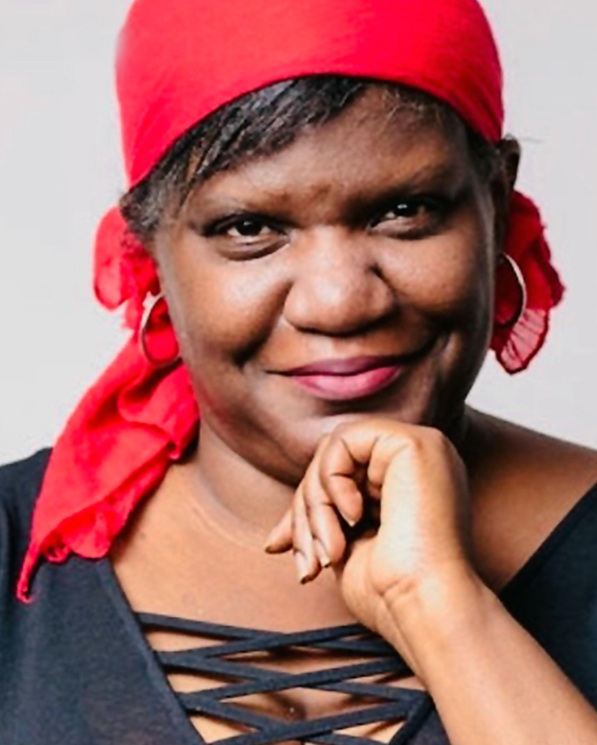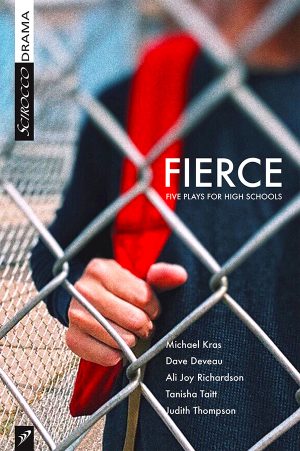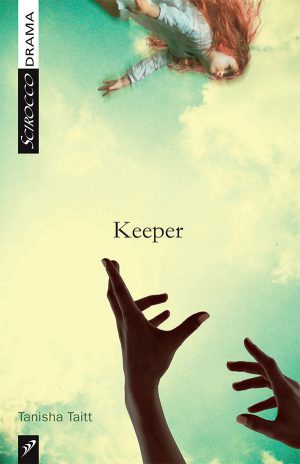Posted July 14, 2022
The Interview – Tanisha Taitt
Tanisha Taitt
In addition to her role as Artistic Director of Cahoots Theatre, Tanisha Taitt is a director/actor/playwright, musical artist, theatre & anti-racism educator, accidental essayist, and audiobook director for Penguin Random House Canada. A former preschool teacher, her creative journey includes encounters with numerous arts organizations. She has been nominated as a director for the Pauline McGibbon Award for Unique Talents, and her plays Admissions and Keeper are published by Scirocco Drama (the former in the anthology FIERCE: Five Plays for High Schools). Tanisha is a recipient of the Canadian Music Publishers Association Award & Scholarship for distinction in songwriting, and was a 2021 finalist for the Gina Wilkinson Prize honouring female theatremakers who centre community in their leadership. She was recently named Co-Coordinator of the joint Theatre & Drama Studies program at Sheridan College/University of Toronto Mississauga, and is an instructor for Sheridan’s Music Theatre Performance program, where she teaches Acting Through Song. She is also part-time faculty at George Brown Theatre School, teaching Contemporary and Canadian Scene Study. Tanisha is a two-time YWCA Woman of Distinction nominee for her commitment to artistic excellence and social justice.
Tanisha, you are one of the busiest people we know! You are an actor, a director, and a playwright; you’re a singer-songwriter, you’re an audiobooks director, you’re an activist, and you’re the Artistic Director of Cahoots Theatre. Yet you also find the time to teach at colleges and universities. Why is teaching important to you?
Teaching brings me immeasurable joy! I teach at Sheridan and George Brown colleges; both are amazing. I am also the new Co-Coordinator of the joint Theatre and Drama Studies program at Sheridan College/University of Toronto Mississauga, and I’m excited to get to know and spend time with those students. Why I teach, and why I make time for it regardless of whatever else I’m doing, is because I believe it is the best way to create not only the best artists we can, but the best human beings we can.
In 2021 I taught virtually for Memorial University of Newfoundland; I was offered a 3rd Year master class and given the freedom to determine its focus. I created a course on Contemporary Black Playwrights for the group. Other than A Raisin in the Sun, which two of them had heard of, when the course began, none of the students could name a single play written by a Black writer. Not one. In 3rd Year. Weeks later, half of them were in love with Branden Jacobs-Jenkins. All it took was exposure. My activism is no longer something that I view as needing to occupy its own lane. It is embedded in my teaching. Our industry is a microcosm of the world; it contains all of the beauty but also all of the ignorance. We convince ourselves that because most of us are “progressives,” that we innately do this humanity thing right. But this so-called-progressive industry has fought progress pretty hard. And while it’s true that theatre artists tend to be compassionate folks, there is also a self-righteousness amongst us that can rear its head.
You have long been committed to increasing racial and cultural representation in the performing arts. Can you tell us about how your students engage with racially and culturally specific plays in the classroom?
I’ve given addresses and done workshops on my approach to contemporary scene and play study, so I’ll try to condense it! 90% of the playwrights introduced in my class are of colour or Indigenous. When I include other writers, it is work that confronts race in some way. Master Harold…and the Boys by Athol Fugard, Bang Bang by Kat Sandler, and The Seat Next to the King by Steven Elliott Jackson are the three plays by white writers currently in my syllabus.
I see my class as an opportunity to immerse students in what I know they are not being exposed to in other courses. They spend three or four years studying white writers, which is insufficient and frankly, negligent. The notion that racism has to be malicious or intentional is a fallacy. The damaged often learn to smile. You can be the nicest, most well-intentioned white educator alive and be robbing and negating your students of colour in egregious ways. How in God’s name is any North American theatre student getting a diploma or degree without cracking the spine of an August Wilson or Lynn Nottage play? These are two-time Pulitzer winners; Wilson is the most celebrated African-American playwright in history and our grads are finishing their theatre education never having read a word of his work. Today’s students should be reading everything Dominique Morisseau writes. How are aspiring Canadian practitioners not being exposed to Djanet Sears or Tomson Highway? And how do so many educators teach only work written from a white lens and never question if they are failing their students? It is tacit racism. Period. “Tradition” is not innocent when birthed from entrenched prejudice. It says—without ever saying it out loud— that everything deemed to be worthy, necessary knowledge in order to graduate is European. That is white supremacist education. You can say that that’s harsh and you call it whatever the hell else you want. It doesn’t make it less true.
With regards to performance in Scene Study class, I believe that it’s incredibly important for students to experiment and explore by traversing the cultural and racial barriers that exist in professional settings. No one is putting on a professional production of Kim’s Convenience or Fences with a white cast, and no one ever should. We all know that. But school is a place to learn, and I sometimes give my students of European descent the experience of playing characters of other races. That is controversial for some, but it is sheer magic in this class and I stand by it 100%. I don’t choose scenes that centre race, as having a white kid give a monologue about living Asian life would be ridiculous. I look at the humanity of the scene, the writing, the universality in the particular. I weigh the opportunity it provides in terms of the rigour and the stretch that it demands—and I match scenes to actors.
The students are often nervous at first, particularly the white ones, but a few nerves never hurt anyone. They experience just an iota of what it’s like for their classmates of colour to play (over and over again) characters that were written as white. And it allows me to bring in a LOT of non-white plays. What I love is how quickly everyone dives into the storytelling and into finding the essence of their characters. I don’t ask a white student to “be Arab” or an Indigenous student to “be Black.” I ask them to play thinking, feeling human beings in specific circumstances, and to roll around in the muck of those circumstances. It is an excavation of empathy, nudging actors into realms of experience far outside of their own.
I give my students of colour work written for them, and I always cast them first because they are often afterthoughts when cast in white stories. They’re usually ecstatic and moved because it’s the first time they’ve gotten to play a character who looks like them. In class we talk a LOT about the plays. We forage every play in the syllabus, together. When the students are watching each other present their scenes, they’re not just watching isolated bits of plays they know nothing about. Every play has been read, discussed and thoroughly mined as a class, so when each pair or group gets up to perform, the whole class is already wholly invested in the story and deeply understands the scene they are watching in the context of the full play.
It is always stated how important it is for the students of colour to see themselves reflected in the work. That is a given. That is the most obvious truth. But it is just as crucial that the white students come to understand that greatness does not only look like them. It’s imperative to me that white students be steeped in BIPOC excellence, and that they head out into their careers with much more egalitarian views about who and what is excellent. It’s incredibly rewarding to not only see my students of colour affirmed and validated in the syllabus—which ignites my heart—but to see them and the white students leave my class in love with the work of Tara Beagan or Dominique Morisseau. I know minds that have expanded and that these students are going forward with a broader sense and a deeper appreciation of what great playwriting is.
In recent years, you have been involved with curriculum development at Sheridan College. Will you tell us more about your approach to this important work?
I actually haven’t been involved with curriculum development at Sheridan, but I am going to be as of this year. So, you must be prescient, Glenda! I am taking on a slightly larger role at Sheridan. I’m currently part-time teaching faculty in the Music Theatre Performance program; I will also be working with the non-musical theatre program this coming year. One of the things that I will be doing in concert with other faculty members and the associate dean is looking at the curriculum and how we can make sure that it is a vital, relevant, memorable and forward-looking program for the students.
We have always had a wealth of talented BIPOC writers and performers in Canada, but many were not given the opportunities they should have had. Do you think that the landscape is changing for BIPOC artists? (If so, is it changing fast enough?)
I do think that the landscape is starting to change, but not necessarily in all of the right places. We see more actors of colour on stage and that’s great, but we’re nowhere near where we need to be in terms of works of non-white playwrights being programmed and non-white directors and designers getting to put their visions on stage. There are so many white artists, men in particular, who believe that they are gods—playwriting gods, directing gods, acting gods, design gods—but they were simply the ones provided the nurturance and the opportunities repeatedly, therefore they were given the chance to rise in stature. It has zero to do with them being more innately talented than any other demographic. So now we’re in this place where there isn’t a talent gap, but there is a huge experience gap. The only way to overcome that is to really begin taking more chances on gifted artists of colour who haven’t traditionally been hired because they just weren’t in the club. Things are improving, for sure, but I wish that many of these changes had happened without diversity mandates tied to funding. There are people of colour being hired because grants demand that companies reflect the country more accurately. It’s vile that some organizations have to be threatened with a lack of funding for them to do the right thing. The artists being hired are outstanding, and the companies know they’re outstanding. That’s why it sickens me that so many leaders had to have their arms twisted to do the hiring that they should’ve been doing for decades.
I also wish that the changes happening had happened without George Floyd’s neck being crushed.
So many opportunities now are being given to younger Indigenous artists and artists of colour, from their late teens through their 30s. That’s fantastic. But what it means is that a lot of artists of colour—those in their early 40s to their 60s, just never had their shot. They were overlooked during the time in which the concept of “BIPOC” wasn’t yet a thing in the industry, despite the fact that they were the ones relentlessly pounding the pavement seeking representation. Now not only are they not the ones getting the calls, but they’re watching much younger artists with far less experience being given mainstage opportunities that they never got. It’s bittersweet, because there is such abundant joy to see the next generation finally breaking through, yet such pain at what artists now deemed “middle-aged” were never afforded in their own careers. The advocacy that was done by these artists is now bearing fruit for the younger set, while the older artists were skipped over and denied the opportunities that they so deserved.
These last years have obviously been challenging for theatre people. As things begin to open up, are there any pandemic “lessons” you think we should take with us into the future?
One by-product of COVID that I would like to see continue is virtual programming. What a gift it’s been to watch work in other parts of the country from my living room! What that has done for accessibility is extraordinary. At Cahoots, from 2020 to 2022 we were able to open up our artist development programs to people from BC to Newfoundland. That is absolutely amazing. I also saw that when theatre returned, a lot of people jettisoned the idea of 6-day rehearsal weeks and 10/12 tech days. If that’s what people need to do to be healthy and not burn out, that’s a good thing. I don’t know why as theatre artists we feel that we have to martyr ourselves for the work. We think that we’re not rigorous or serious if we’re not doing insane hours. Or we believe that because we may not have steady work 52 weeks a year, that when we do have it we have to absolutely kill ourselves. None of that is true.
I think the pandemic has also allowed people to strike more of a work/life balance, as so many people by necessity began working from home and then realized how much easier it was for them to structure their lives by doing so. Companies should continue to be truly open to that. In addition, things like 4-day work weeks and accommodations for child care and caregiver needs have become part of the mainstream conversation. That is SO promising. We carry so much in everyday life; in a pandemic, stresses are amplified. Last year we created a Compassionate Care Fund at Cahoots and it is a budget line on every piece of programming that we do. Needing a babysitter or not having bus fare shouldn’t stunt a career. I hope that some of the thoughtfulness and consideration that has begun sector-wide, in terms of how we can honour and integrate all facets of our lives in a more complementary and congruent way, can continue. It is our life’s work in this industry to explore the human condition, is it not? It only follows that taking care of each other should be something we do naturally—in the classroom, the rehearsal hall, or wherever we gather to tell the stories of who we are.



